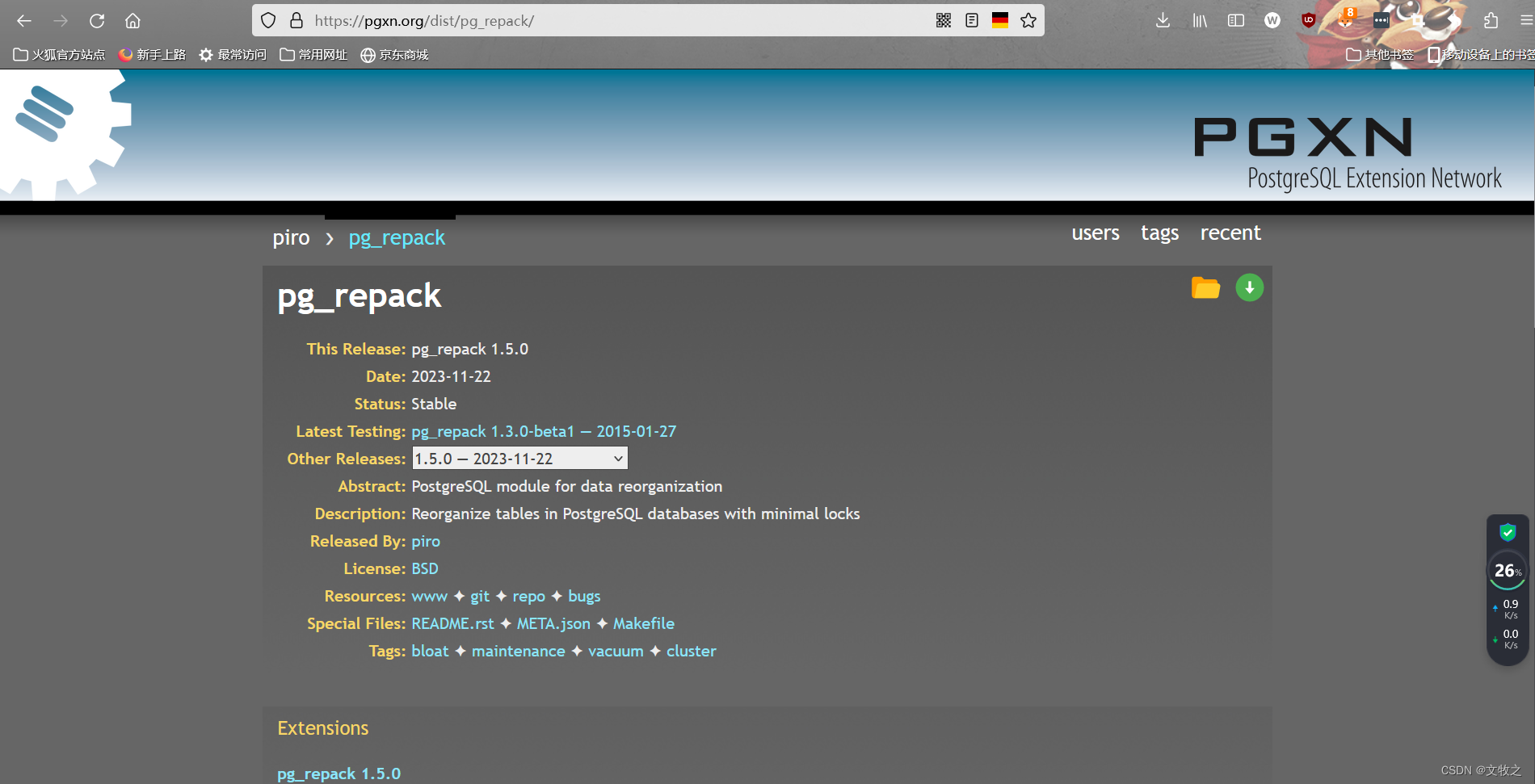PostgreSQL的扩展(extensions)-常用的扩展之pg_repack
基础信息
OS版本:Red Hat Enterprise Linux Server release 7.9 (Maipo)
DB版本:16.2
pg软件目录:/home/pg16/soft
pg数据目录:/home/pg16/data
端口:5777
pg_repack 是一款非常有用的 PostgreSQL 扩展工具,它能够重新打包(repack)表和索引以回收空间并减少碎片,而且在这个过程中不会锁定表,允许数据库在重整过程中继续对数据进行读写操作。这是与 PostgreSQL 内建的 VACUUM FULL 命令相比的一个重大优势,因为 VACUUM FULL 在重新组织表以回收空间时会锁定表。
特性
- 最小化锁定时间:
pg_repack在重组表和索引的时候减少了锁的使用时间,使得数据库对于读写操作几乎总是可用的。 - 重新打包表和索引:不仅可以对表进行重新打包,还可以重新打包索引,减少索引碎片。
- 兼容性:支持多个 PostgreSQL 版本。
安装 pg_repack
从源代码安装
如果你的系统没有预打包的 `pg_repack` 版本,你可以从源代码编译安装。
下载网址:https://pgxn.org/dist/pg_repack/

--编译安装
cd /home/pg16/resource
[pg16@test resource]$ unzip pg_repack-1.5.0.zip
[pg16@test resource]$ cd pg_repack-1.5.0/
[pg16@test pg_repack-1.5.0]$ make
[pg16@test pg_repack-1.5.0]$ make install
当你安装好 pg_repack 后,需要在目标数据库上创建扩展,例如当前是在postgres 库上创建
[pg16@test pg_repack-1.5.0]$ psql -p 5777
psql (16.2)
Type "help" for help.
postgres=# CREATE EXTENSION pg_repack;
CREATE EXTENSION
postgres=# SELECT * FROM pg_extension;
oid | extname | extowner | extnamespace | extrelocatable | extversion | extconfig | extcondition
-------+--------------------+----------+--------------+----------------+------------+-----------+--------------
14270 | plpgsql | 10 | 11 | f | 1.0 | |
16423 | pg_stat_statements | 10 | 2200 | t | 1.10 | |
16454 | pg_repack | 10 | 2200 | f | 1.5.0 | |
(3 rows)
使用 pg_repack
通过help查看帮助文档。
[pg16@test ~]$ pg_repack --help
pg_repack re-organizes a PostgreSQL database.
Usage:
pg_repack [OPTION]... [DBNAME]
Options:
-a, --all repack all databases
-t, --table=TABLE repack specific table only
-I, --parent-table=TABLE repack specific parent table and its inheritors
-c, --schema=SCHEMA repack tables in specific schema only
-s, --tablespace=TBLSPC move repacked tables to a new tablespace
-S, --moveidx move repacked indexes to TBLSPC too
-o, --order-by=COLUMNS order by columns instead of cluster keys
-n, --no-order do vacuum full instead of cluster
-N, --dry-run print what would have been repacked
-j, --jobs=NUM Use this many parallel jobs for each table
-i, --index=INDEX move only the specified index
-x, --only-indexes move only indexes of the specified table
-T, --wait-timeout=SECS timeout to cancel other backends on conflict
-D, --no-kill-backend don't kill other backends when timed out
-Z, --no-analyze don't analyze at end
-k, --no-superuser-check skip superuser checks in client
-C, --exclude-extension don't repack tables which belong to specific extension
--error-on-invalid-index don't repack tables which belong to specific extension
--switch-threshold switch tables when that many tuples are left to catchup
Connection options:
-d, --dbname=DBNAME database to connect
-h, --host=HOSTNAME database server host or socket directory
-p, --port=PORT database server port
-U, --username=USERNAME user name to connect as
-w, --no-password never prompt for password
-W, --password force password prompt
Generic options:
-e, --echo echo queries
-E, --elevel=LEVEL set output message level
--help show this help, then exit
--version output version information, then exit
Read the website for details: <https://reorg.github.io/pg_repack/>.
Report bugs to <https://github.com/reorg/pg_repack/issues>.
在安装并配置 pg_repack 之后,你可以通过命令行工具 pg_repack 来重新组织表和索引。以下是一些基本用法:
示例1
重新打包特定表,如 yewu1.t4
[pg16@test ~]$ pg_repack -d white -t yewu1.t4
INFO: repacking table "yewu1.t4"
示例2
重新打包指定数据库的所有表
[pg16@test ~]$ pg_repack -d white
INFO: repacking table "public.pgbench_accounts"
INFO: repacking table "public.pgbench_branches"
INFO: repacking table "public.pgbench_tellers"
INFO: repacking table "yewu1.t4"
示例3
重新打包索引
[pg16@test ~]$ pg_repack -d white --only-indexes -t yewu1.t4
INFO: repacking indexes of "yewu1.t4"
INFO: repacking index "yewu1.idx_t2"
INFO: repacking index "yewu1.idx_t4"
INFO: repacking index "yewu1.t4_pkey"
请记得,使用 pg_repack 之前,确保你已经有了足够的权限来执行这些操作,并且对数据库做了适当的备份。
注意事项
- 在
pg_repack运行期间,尽管它最小化了锁的时间,但在最后阶段仍然需要短暂的锁定,以便完成表的替换。因此,最好在数据库负载相对较低的时间段运行它。 - 确保在执行大量数据重组之前备份数据库,以免出现不可预测的情况导致数据丢失。
谨记:心存敬畏,行有所止。





















 4413
4413











 被折叠的 条评论
为什么被折叠?
被折叠的 条评论
为什么被折叠?








